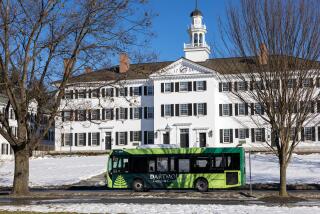Study Hall
Nicholas Lemann tells many fascinating stories in âThe Big Test,â and he tells them with an unusual combination of lively prose and discerning intelligence. But the subtitle of his book is misleading. The stories he relates are not all that secret, they do not add up to a coherent history and only some of them are about the American meritocracy.
Just as democracy means the rule of the people, meritocracy means rule by the talented. It is supposed to work like this: The best places and the best colleges and therefore the best jobs ought to go to those who have the highest ârawâ intelligence. Implied in the idea is that we can measure intelligence and that it ought to be valued over other methods of choosing an elite, such as a reliance on the old boysâ network of personal connection.
Lemannâs book basically begins with the founding of the Educational Testing Service in 1948. The brainchild of Harvardâs James Bryant Conant and Henry Chauncey, the ETS was viewed by its founders as a fulfillment of Thomas Jeffersonâs hope that a ânatural aristocracyâ of talent would emerge in
the United States. Launching a revolution against their own class of privileged white Anglo-Saxon Protestants, Conant and Chauncey wanted to put in place a system that would skim off the best brains from all social classes, educate them and place them in positions of power and responsibility. (That they were opponents of privilege did not make them democrats. Conant in particular argued against measures such as the G.I. Bill which, in opening higher education to the many, created more opportunity for more people than this country had previously.)
The only effective way to create such a natural aristocracy was through a âbig test,â an exam valid enough to sort out the genius from the run of the mill and reliable enough to win the trust of those who took it. A believer in the predictive power of social science, Chauncey developed plans for a census of abilities, an effort, in Lemannâs words, âto mount a vast scientific project that will categorize, sort, and route the entire population.â
Though Chauncey never realized the full ambitions of a vast census of abilities, the ETS, and especially its Scholastic Aptitude Test, became a fixed feature of middle-class life in America. Lemannâs account of its early years explores the many, often duplicitous, ways that the ETS became a commercial monopoly in the guise of presuming to be a nonprofit organization offering a public service. Along the way, Lemann offers captivating portraits of key individuals. Among them is Carl Brigham, the inventor of the SAT and one of the first people to recognize that what it measured was not some innate and unvarying neurological phenomenon called intelligence. Stanley Kaplan, actually a great admirer of the ETS but a man who proved that preparation could indeed improve scores, is profiled with loving care. Clark Kerr, the man who used intelligence tests to build the hugely successful University of California system of higher education, is clearly not someone Lemann admires, but his treatment of Kerr is sympathetic and engaging.
Lemann writes as if the story he tells has never been told before. Americans, he suggests, blinded by their faith in science, have been naive about the plans these covert meritocrats had for them. That may have been true in the 1950s, but Americans are now as cynical about testing as they are about other sources of authority in their lives. Lemann offers fascinating details but not much that is original about the big picture. If anything, his book confirms the general impression most Americans hold about the meritocracy: It is an improvement on the old days of the WASP establishment, but it has its own biases and contradictions.
*
Nor is âThe Big Testâ a consistent history. Halfway through the book, Lemann shifts the focus of his account from the ETS itself to the lives of a number of young âmeritocrats,â individuals who made it during the 1970s and 1980s through Harvard or Yale on the strength of their intelligence and determination. Coincidentally each of these individuals would play an important role in the struggle against Proposition 209, which abolished affirmative action in California government. Because these are people who went far on raw ability, their life histories raise important questions, Lemann argues. What kind of meritocracy do we want? Should it be based purely on intelligence? Or should our leadership reflect the diversity of the country?
The problem is that the link between their personal histories and larger questions of merit here is tenuous at best, giving âThe Big Testâ a herky-jerky quality. There is a randomness to the introduction of the characters who occupy the second half of the book. To be sure, the life of the daughter of Warren Buffettâs business partner is interesting, but she is anything but a representative figure for the larger points Lemann wants to make. And his portrait of Berkeley sociologist Jerome Karabel, for a while a key player in the fight over Proposition 209, is told so much through Karabelâs eyes that one can only wonder whether others saw Karabel quite the way he himself did.
If one wanted to get a sense of the meritocracy through real individuals, it would make more sense to interview the engineers and scientists who were the true beneficiaries of the system. But then one would also not have found the historic drama of meritocrats fighting over how diverse the meritocracy should be because scientists and engineers, unlike professors and idealistic lawyers, do not pay much attention to affirmative action. This, in turn, suggests that affirmative action does not in fact raise the question of what kind of meritocracy America should have. It raises the far more radical question of whether we should have a meritocracy at all.
And that is the question Lemann addresses in his conclusion. We ought to stop using education as a way of determining who should occupy positions in our national elite, Lemann believes. âThe chief aim of school should be not to sort out but to teach as many people as possible as well as possible, equipping them for both work and citizenship,â he writes.
Lemann believes that so great, and therefore so unfair, are the benefits that accrue to those who attend the best colleges that Lemann would do away with the whole concept of highly selective colleges. Because our preoccupation with getting our children into those colleges âhas gone past the bounds of rationality,â we need to abolish the privileges set in place by a meritocracy which first arose to abolish the privileges of the gentlemanly class.
As fine as these sentiments are, they fail to answer the difficult question of how a society ought to choose its leaders. Lemann is right to insist that intelligence, as measured by test performance, is only one quality among many and may not be as important as good character or an ability to overcome obstacles. But in a large and complex society, admitting people to the best colleges based on something resembling an objective test is fair. Until something better and more efficient comes along, most people are going to try to do as well on the SAT as they can, leaving for some future time its possible abolition.
More to Read
Sign up for our Book Club newsletter
Get the latest news, events and more from the Los Angeles Times Book Club, and help us get L.A. reading and talking.
You may occasionally receive promotional content from the Los Angeles Times.








